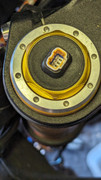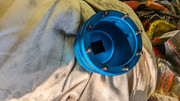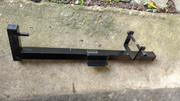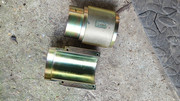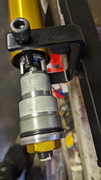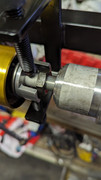The forks work like normal (right way up) or upside-down ones but the damping (compression and rebound) is controlled by a little electric motor in the fork leg, and it senses the road conditions and riding style using (usually) a six-axis motion sensor in the ECU and adjust the compression and rebound damping to suit, as you ride. The measurements and adjustments can take place many times a second, so it is dynamic.But it can't predict what's not yet happened, so, for instance, automatically softening the forks' compression setting as you approach a bumpy section of road isn't possible, (Yet!) -although you can, on most bikes, change suspension maps by pressing a button or two while you're riding. So as you turn off a motorway onto more twisty roads, you can stiffen everything up.
You still have to adjust preload manually in mine, but I see that some bikes now have automatic preload adjustment on the rear, or even front and rear) which senses whether you are carrying a pillion or luggage and adjusts accordingly. Mine doesn't, so I won't cover that in this how-to.
The rider can pre-select a set of parameters which offer a range of settings to suit your ride, for example a softer setting for motorway cruising, a stiffer set when you're romping on a bit, and a setup suitable for a racetrack. They might be called A, B and C, or Road, Race and Track, or something else. Each manufacturer seems to use differing names or acronyms. There are often some personal settings options, where a rider can select their own preference for each group of settings, and save these as a map that they can select when needed. As an example, I like a particular map but find the throttle action a bit quick for bumpy roads, so I have saved a map with a slower throttle action for times when I want to use it. I also prefer a bit more steering damper (yes, they can be controlled electronically, too).
Usually there are other adjustments contained within these packages, such as how quickly the throttle opens the throttle bodies (mimicking a quick action throttle), traction control, ABS, how high the bike can wheelie, steering damper setting and, often, rear shock settings, too.
So because this type of forks are connected to a lot of complicated electronics they might seem a bit daunting to service, even if you are happy servicing non-electronic forks.
I wrote this to try to demystify the process of servicing this type of fork. Basically, they're pretty much the same to service, apart from unplugging the electrical connector, but although I have serviced right-way up and upside-down forks many times in the past, (mostly on Honda's), Ohlins are a little different.
Lots of people on this forum have other bikes, and some of these have leccy legs- hopefully, this will be useful when yours needs a service.
Lastly: no, sorry
By the time you've added all that, it's way too expensive to be a possibility, even if you could find suitable parts. It would make much more sense to sell your bike and buy one that has all of this as standard.
In the next part I'll talk about the tools you will need.
